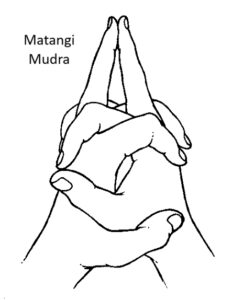Matangi Mudra
Introduction
Matangi Mudra is a yogic hand gesture dedicated to Goddess Matangi, one of the Mahavidyas (wisdom goddesses) in Tantric and Yogic traditions. Known as the Tantric Saraswati, she represents inner harmony, knowledge, speech, and the power of transformation.
The mudra is primarily used to restore mental clarity, inner balance, and emotional stability. It is also regarded as a powerful gesture for harmonizing the solar plexus (Manipura Chakra) and boosting inner strength.
Meaning
The word Matangi comes from Mata (mother) + anga (part or limb).
Symbolically, it represents union with universal energy through aligning the inner self.
The mudra is considered a seal of harmony and inner alignment, helping to regulate conflicting forces of mind and body.
How to Perform (Practice)
Sit comfortably in Padmasana, Sukhasana, or Vajrasana with a straight spine.
bring both hands together and interlace all your fingers.
Release both middle fingers and extend them, keeping them pressing against each other and pointing upward.
Relax the shoulders, close the eyes, and breathe deeply.
Focus attention on the solar plexus (Manipura Chakra).
Practice for 5–15 minutes at a time, up to 2–3 times daily.
Benefits
Physical Benefits
Strengthens the digestive system.
Improves breathing capacity and supports lung function.
Enhances circulation and energy flow.
Reduces fatigue, exhaustion, and weakness.
Mental & Emotional Benefits
Creates inner harmony and calms emotional turbulence.
Reduces stress, nervousness, and anxiety.
Improves confidence, focus, and clarity of thought.
Brings balance in relationships by reducing anger and frustration.
Spiritual Benefits
Activates the Manipura Chakra (solar plexus) – the seat of willpower and self-esteem.
Enhances intuition, inner guidance, and creativity.
Invokes the blessings of Goddess Matangi for wisdom and clarity in speech.
Aligns personal energy with universal harmony.
Contraindications
Avoid during high blood pressure or heart-related conditions (if practiced too long).
Should not be practiced during acute digestive disorders without guidance.
Excessive practice may overstimulate and lead to restlessness.
Anatomy & Physiology
Engages the respiratory diaphragm by directing awareness to deep abdominal breathing.
Stimulates the vagus nerve, inducing relaxation and regulating the autonomic nervous system.
Supports liver, pancreas, and stomach functions by energizing Manipura region.
Helps regulate the endocrine system, particularly adrenal glands.
Kinesiology
Interlaced fingers activate flexor digitorum profundus, lumbricals, and interossei muscles.
Upright middle fingers engage extensor digitorum and stabilize hand posture.
Creates neuromuscular awareness linking hand gestures with abdominal core muscles.
Neurology
Stimulates brain centers linked to confidence, balance, and speech regulation.
Strengthens parasympathetic dominance, calming overactivity of stress circuits.
Promotes coherence between right and left brain hemispheres.
Supports mental clarity and improved executive functions in the prefrontal cortex.
Duration of Practice
Beginners: 5 minutes daily.
Intermediate: 10–15 minutes, twice daily.
Advanced: Up to 30 minutes in meditation or pranayama practice.
Best practiced in the morning or when seeking calm and inner strength.
Counter Mudra
Apana Mudra – for grounding and reducing overstimulation.
Shakti Mudra – for deep relaxation and calming energy after Matangi practice.
Dhyana Mudra – for balance in meditation after energizing manipura chakra.
Conclusion
Matangi Mudra is a powerful gesture for harmony, clarity, and empowerment. By activating the solar plexus, it balances emotions, supports digestion, and enhances confidence. Spiritually, it connects the practitioner with inner wisdom and creativity, making it a valuable tool for meditation, stress management, and personal growth.
FAQ
Q1. Can Matangi Mudra help with stress?
Yes, it calms the nervous system, reduces anxiety, and promotes inner peace.
Q2. Can beginners practice it daily?
Yes, starting with 5–10 minutes is safe and effective.
Q3. Which chakra does it activate?
Primarily the Manipura Chakra (solar plexus).
Q4. Can it be combined with pranayama?
Yes, it works well with deep abdominal breathing, Kapalabhati, or Anulom Vilom.
Q5. Is it beneficial for public speakers or students?
Yes, it improves confidence, clarity of thought, and speech.
References
Swami Satyananda Saraswati – Asana, Pranayama, Mudra, Bandha.
Gertrud Hirschi – Mudras: Yoga in Your Hands.
Vasant Lad – Ayurveda: Science of Self-Healing.
David Frawley – Yoga and Ayurveda.
Research on yoga mudras, vagus nerve activation, and stress regulation.

